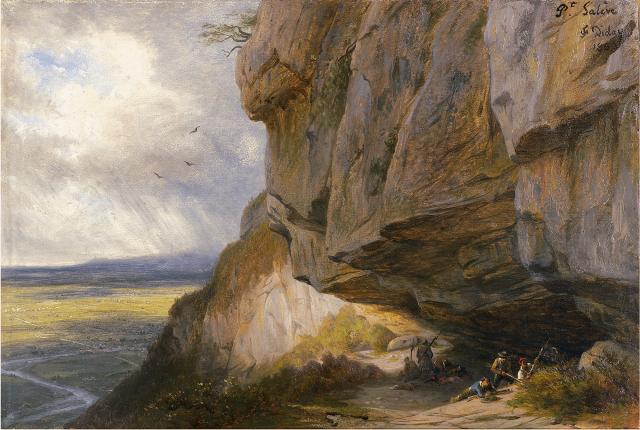The subject of La Grotte du Petit Salève (The Cave of the Petit Salève, 1868) isn’t representative of François Diday’s output. Diday is mostly known for his landscapes depicting the Alps or the shores of Lake Geneva.
This painting, however, gives pride of place to a mass of rock that the viewer is invited to admire down to the irregularities in the stone. The mass dominates the foreground, conspicuously standing out from the rear of the composition, where an indistinct view of the plain can be seen. Clouds crowd the sky, letting through a few rays of sunlight which mould and sculpt the great formation of compact rock.
This is a painting that is less formally composed than Diday’s other canvases and is characteristic of the spontaneity and freshness of landscape studies. Such concern for a highly precise depiction of nature recalls the work of Caspar Wolf, a Swiss-German artist and native of Aargau. Although nothing suggests that Diday is familiar with the work of latter, he does offer a similar naturalist treatment of the rock and cave, motifs that play to the period’s taste.
The care lavished on the rendering of the geology here demonstrates an in-depth knowledge of the mountainous landscape, which Diday will roam over on foot for nearly fifty years. The few figures peopling the foreground are meant to signify that the Petit Salève, unlike high mountains, offers access to humans. In this then, the composition differs greatly from the depictions of the Alps, where, in the austerity of the soaring peaks, human beings are never represented.
This painting, however, gives pride of place to a mass of rock that the viewer is invited to admire down to the irregularities in the stone. The mass dominates the foreground, conspicuously standing out from the rear of the composition, where an indistinct view of the plain can be seen. Clouds crowd the sky, letting through a few rays of sunlight which mould and sculpt the great formation of compact rock.
This is a painting that is less formally composed than Diday’s other canvases and is characteristic of the spontaneity and freshness of landscape studies. Such concern for a highly precise depiction of nature recalls the work of Caspar Wolf, a Swiss-German artist and native of Aargau. Although nothing suggests that Diday is familiar with the work of latter, he does offer a similar naturalist treatment of the rock and cave, motifs that play to the period’s taste.
The care lavished on the rendering of the geology here demonstrates an in-depth knowledge of the mountainous landscape, which Diday will roam over on foot for nearly fifty years. The few figures peopling the foreground are meant to signify that the Petit Salève, unlike high mountains, offers access to humans. In this then, the composition differs greatly from the depictions of the Alps, where, in the austerity of the soaring peaks, human beings are never represented.
